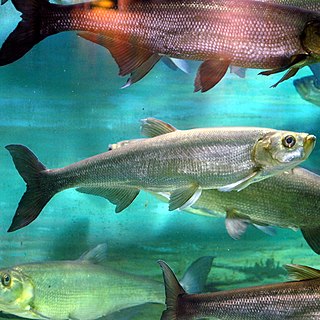
A tuna is a saltwater fish that belongs to the tribe Thunnini, a subgrouping of the Scombridae (mackerel) family. The Thunnini comprise 15 species across five genera, the sizes of which vary greatly, ranging from the bullet tuna up to the Atlantic bluefin tuna, which averages 2 m (6.6 ft) and is believed to live up to 50 years.

Mackerel is a common name applied to a number of different species of pelagic fish, mostly from the family Scombridae. They are found in both temperate and tropical seas, mostly living along the coast or offshore in the oceanic environment.

Herring are various species of forage fish, belonging to the order Clupeiformes.

The International Union for Conservation of Nature (IUCN) Red List of Threatened Species, also known as the IUCN Red List or Red Data Book, founded in 1964, is an inventory of the global conservation status and extinction risk of biological species. A series of Regional Red Lists, which assess the risk of extinction to species within a political management unit, are also produced by countries and organizations.

Sardine and pilchard are common names for various species of small, oily forage fish in the herring suborder Clupeoidei. The term 'sardine' was first used in English during the early 15th century; a somewhat dubious etymology says it comes from the Italian island of Sardinia, around which sardines were once supposedly abundant.
The conservation status of a group of organisms indicates whether the group still exists and how likely the group is to become extinct in the near future. Many factors are taken into account when assessing conservation status: not simply the number of individuals remaining, but the overall increase or decrease in the population over time, breeding success rates, and known threats. Various systems of conservation status are in use at international, multi-country, national and local levels, as well as for consumer use such as sustainable seafood advisory lists and certification. The two international systems are by the International Union for Conservation of Nature (IUCN) and The Convention on International Trade in Endangered Species of Wild Fauna and Flora (CITES).

The smallfin gulper shark or endeavour dogfish, is a medium-sized deepwater dogfish in the family Centrophoridae.
Sinibrama of freshwater ray-finned fish belonging to the family Xenocyprididae, the East Asian minnows or sharpbellies. The fihses in this genus are found in southern China, Taiwan, Laos, and Vietnam. These are silvery fishes with deep, laterally compressed bodies, large eyes, and terminal mouths. They tend to grow no larger than 20 cm in standard length.
Percina austroperca, the southern logperch, is a small species of freshwater ray-finned fish, a darter from the subfamily Etheostomatinae, part of the family Percidae, which also contains the perches, ruffes and pikeperches. They are highly resilient with a minimum population doubling time of less than 15 months. It is found in the Escambia and Choctawhatchee river systems in western Florida and southern Alabama.
Stenodus nelma, known alternatively as the nelma, sheefish, siifish, inconnu or connie, is a commercial species of freshwater whitefish in the family Salmonidae. It is widespread in the Arctic rivers from the Kola Peninsula eastward across Siberia to the Anadyr River and also in the North American basins of the Yukon River and Mackenzie River.
Sinibrama affinis is a species of ray-finned fish in the genus Sinibrama. It is found in southern China, northern Vietnam, and Laos. It inhabits rivers.
Sinibrama longianalis is a species of ray-finned fish in the genus Sinibrama. This species is endemic to Guizhou in China.
Sinibrama macrops is a species of ray-finned fish in the genus Sinibrama. It is found in southern and southeastern China and in Taiwan. It lives in rivers in slow, deep water.
Sinibrama taeniatus is a species of ray-finned fish in the genus Sinibrama.
Sinibrama wui is a species of ray-finned fish in the genus Sinibrama which is endemic to China. It is the type species of the genus Sinibrama but there is some controversy as to which form was described first. If the form described by S.Y Lin in 1932 is considered specifically distinct from that described by Rendahl then the form named by Rendahl should revert to the binomial Sinibrama typus.

Umpqua dace is a species of ray-finned fish in the genus Rhinichthys. It is endemic to the United States where it inhabits the Umpqua River drainage in Oregon.

Umatilla dace is a species of ray-finned fish in the genus Rhinichthys. It is found in the drainage basin of the Columbia River in British Columbia, Washington state, Oregon and Idaho.

The Cultrinae are one of at least 13 subfamilies of cyprinid fish. It contains ten genera.









